 |
 |
Our enthusiastic and extremely knowledgeable perennials team is here to answer your questions and help you choose the best perennials for your situation. There’s always something in bloom for sun, shade, butterflies, birds or deer resistance as well as a variety of bulbs for your space.
Stroll through our time-tested favorites and introduce yourself to the newest varieties. We garden with perennials too; we love them and it shows!
|
110 found, showing page 1 of 8
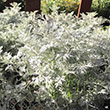
Outstanding silver-green, lacy leaves and stems. Excellent contrast plant in the sunny perennial garden. Drought tolerant. Deer resistant. USDA 6-9
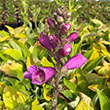
Lavender blooms on spires. Self-seeding biennial. Toxic. USDA 4-9
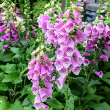
Plant Height: 3 feet
Flower Height: 4 feet
Spacing: 14 inches
Sunlight: full sun, partial shade
Hardiness Zone: 4a
Group/Class: Dalmatian Series Description:
Exciting rose-purple tubular flowers with white interiors and dark purple spots; tall spikes rise above attractive green lance-shaped leaves; a biennial that's happiest in part shade with adequate moisture
Ornamental Features:
Dalmatian Rose Foxglove features bold spikes of rose tubular flowers with violet overtones and deep purple spots rising above the foliage from late spring to mid summer. The flowers are excellent for cutting. Its pointy leaves remain green in color throughout the season.
Landscape Attributes:
Dalmatian Rose Foxglove is an herbaceous perennial with a rigidly upright and towering form. Its medium texture blends into the garden, but can always be balanced by a couple of finer or coarser plants for an effective composition.
This plant will require occasional maintenance and upkeep, and is best cleaned up in early spring before it resumes active growth for the season. It is a good choice for attracting hummingbirds to your yard, but is not particularly attractive to deer who tend to leave it alone in favor of tastier treats. Gardeners should be aware of the following characteristic(s) that may warrant special consideration:
-Self-Seeding
Dalmatian Rose Foxglove is recommended for the following landscape applications:
- Vertical Accent
- Mass Planting
- General Garden Use
- Container Planting
- Planting & Growing
Dalmatian Rose Foxglove will grow to be about 3 feet tall at maturity extending to 4 feet tall with the flowers, with a spread of 18 inches. When grown in masses or used as a bedding plant, individual plants should be spaced approximately 14 inches apart. It tends to be leggy, with a typical clearance of 1 foot from the ground, and should be underplanted with lower-growing perennials. It grows at a fast rate, and tends to be biennial, meaning that it puts on vegetative growth the first year, flowers the second, and then dies. However, this species tends to self-seed and will thereby endure for years in the garden if allowed. As an herbaceous perennial, this plant will usually die back to the crown each winter, and will regrow from the base each spring. Be careful not to disturb the crown in late winter when it may not be readily seen!
This plant does best in full sun to partial shade. It does best in average to evenly moist conditions, but will not tolerate standing water. It is not particular as to soil type or pH. It is highly tolerant of urban pollution and will even thrive in inner city environments. This is a selected variety of a species not originally from North America, and parts of it are known to be toxic to humans and animals, so care should be exercised in planting it around children and pets.
Dalmatian Rose Foxglove is a fine choice for the garden, but it is also a good selection for planting in outdoor pots and containers. With its upright habit of growth, it is best suited for use as a 'thriller' in the 'spiller-thriller-filler' container combination; plant it near the center of the pot, surrounded by smaller plants and those that spill over the edges. It is even sizeable enough that it can be grown alone in a suitable container. Note that when growing plants in outdoor containers and baskets, they may require more frequent waterings than they would in the yard or garden.
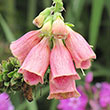
Deep pink blooms on spires. Perennial hybrid. Toxic. USDA 4-8
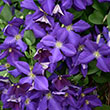
Height: 10 feet
Spread: 24 inches
Sunlight: full sun
Hardiness Zone: 3a
Other Names: Jackman's Clematis
Description:
The granddaddy of clematis, more popular than any other variety and for good reason; this variety features endless waves of rich velvet-blue flowers throughout the season; tough, hardy and thrives with neglect
Ornamental Features:
Jackmanii Clematis features showy royal blue star-shaped flowers with white anthers at the ends of the branches from mid summer to early fall. It has green deciduous foliage. The compound leaves do not develop any appreciable fall color.
Landscape Attributes:
Jackmanii Clematis is a multi-stemmed deciduous woody vine with a twining and trailing habit of growth. Its average texture blends into the landscape, but can be balanced by one or two finer or coarser trees or shrubs for an effective composition.
This is a relatively low maintenance woody vine. It is a Type 3 clematis; each spring it should be pruned back to within a few inches of the ground, as it flowers on new wood of the season. It is a good choice for attracting hummingbirds to your yard. It has no significant negative characteristics.
Jackmanii Clematis is recommended for the following landscape applications:
- Accent
- Hedges/Screening
- General Garden Use
- Container Planting
Planting & Growing:
Jackmanii Clematis will grow to be about 10 feet tall at maturity, with a spread of 24 inches. As a climbing vine, it tends to be leggy near the base and should be underplanted with low-growing facer plants. It should be planted near a fence, trellis or other landscape structure where it can be trained to grow upwards on it, or allowed to trail off a retaining wall or slope. It grows at a medium rate, and under ideal conditions can be expected to live for approximately 20 years.
This woody vine should only be grown in full sunlight. It does best in average to evenly moist conditions, but will not tolerate standing water. It is not particular as to soil type or pH. It is highly tolerant of urban pollution and will even thrive in inner city environments. Consider applying a thick mulch around the root zone in both summer and winter to conserve soil moisture and protect it in exposed locations or colder microclimates. This particular variety is an interspecific hybrid.
Jackmanii Clematis makes a fine choice for the outdoor landscape, but it is also well-suited for use in outdoor pots and containers. Because of its spreading habit of growth, it is ideally suited for use as a 'spiller' in the 'spiller-thriller-filler' container combination; plant it near the edges where it can spill gracefully over the pot. It is even sizeable enough that it can be grown alone in a suitable container. Note that when grown in a container, it may not perform exactly as indicated on the tag - this is to be expected. Also note that when growing plants in outdoor containers and baskets, they may require more frequent waterings than they would in the yard or garden.
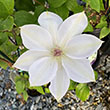
Height: 10 feet
Spread: 24 inches
Sunlight: full sun
Hardiness Zone: 4a
Description:
A positively stunning climber with enormous snowy white flowers with reddish amber centers from mid summer on, looks nothing short of amazing trailing over a dark structure or against a dark wall
Ornamental Features:
Henryi Hybrid Clematis features showy white star-shaped flowers with dark red anthers at the ends of the branches from mid summer to mid fall. It has green deciduous foliage. The compound leaves do not develop any appreciable fall color.
Landscape Attributes:
Henryi Hybrid Clematis is a multi-stemmed deciduous woody vine with a twining and trailing habit of growth. Its average texture blends into the landscape, but can be balanced by one or two finer or coarser trees or shrubs for an effective composition.
This is a relatively low maintenance woody vine. It is a Type 2 clematis, which means it will bloom primarily on old wood of the previous season, with a second flush later in summer. Dead and weak vines should be removed in late winter, and remaining vines should be trimmed back to the first buds that are seen to remove dead stems. It is a good choice for attracting hummingbirds to your yard. It has no significant negative characteristics.
Henryi Hybrid Clematis is recommended for the following landscape applications:
- Accent
- Hedges/Screening
- General Garden Use
- Container Planting
Planting & Growing:
Henryi Hybrid Clematis will grow to be about 10 feet tall at maturity, with a spread of 24 inches. As a climbing vine, it tends to be leggy near the base and should be underplanted with low-growing facer plants. It should be planted near a fence, trellis or other landscape structure where it can be trained to grow upwards on it, or allowed to trail off a retaining wall or slope. It grows at a medium rate, and under ideal conditions can be expected to live for approximately 20 years.
This woody vine should only be grown in full sunlight. It does best in average to evenly moist conditions, but will not tolerate standing water. It is not particular as to soil type or pH. It is somewhat tolerant of urban pollution. Consider applying a thick mulch around the root zone in both summer and winter to conserve soil moisture and protect it in exposed locations or colder microclimates. This particular variety is an interspecific hybrid.
Henryi Hybrid Clematis makes a fine choice for the outdoor landscape, but it is also well-suited for use in outdoor pots and containers. Because of its spreading habit of growth, it is ideally suited for use as a 'spiller' in the 'spiller-thriller-filler' container combination; plant it near the edges where it can spill gracefully over the pot. It is even sizeable enough that it can be grown alone in a suitable container. Note that when grown in a container, it may not perform exactly as indicated on the tag - this is to be expected. Also note that when growing plants in outdoor containers and baskets, they may require more frequent waterings than they would in the yard or garden.
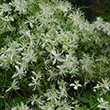
Sweetly fragrant white blooms. Attracts hummingbirds. Tolerates deer & shade. Fast growing. USDA 5-9
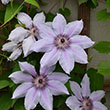
Showy pale pink flowes with carmine midstripe. Blooms on old and new growth. USDA 4-8
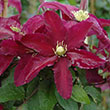
Vigorous large, velvety, deep ruby-red flowers, 6 in across. Tolerate deer and black walnut. USDA 4-11

Profuse ruffled pale pink 5-6" flowers with a wide, deep reddish pink central bar. Thrives in full sun, tolerates shade. Blooms in spring and summer. USDA 4-11

Massive clusters of vibrant, magenta flowers bloom profusely in summer. Vigorous grower. USDA 4-11
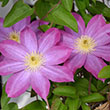
Early blooming compact variety with deep pink flowers and pale centers. Works well in tighter spaces than your traditional varieties. USDA 4-11

Long blooming deep reddish purple flowers from late spring to early fall. Compact. USDA 5-9
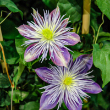
Height: 10 feet
Spread: 24 inches
Sunlight: full sun, partial shade
Hardiness Zone: 4a
Group/Class: Early large-flowered
Description:
Spectacular large, early double lavender-blue flowers with some violet undertones and white, spiky centres, are produced on a vigorous vine, a great plant for the novice and expert gardener alike
Ornamental Features:
Crystal Fountain Clematis features showy lavender star-shaped flowers with violet overtones and white centers at the ends of the branches from late spring to early fall. It has green deciduous foliage. The compound leaves do not develop any appreciable fall color.
Landscape Attributes:
Crystal Fountain Clematis is a multi-stemmed deciduous woody vine with a twining and trailing habit of growth. Its average texture blends into the landscape, but can be balanced by one or two finer or coarser trees or shrubs for an effective composition.
This is a relatively low maintenance woody vine. It is a Type 2 clematis, which means it will bloom primarily on old wood of the previous season, with a second flush later in summer. Dead and weak vines should be removed in late winter, and remaining vines should be trimmed back to the first buds that are seen to remove dead stems. It is a good choice for attracting bees and hummingbirds to your yard. It has no significant negative characteristics.
Crystal Fountain Clematis is recommended for the following landscape applications
- Accent
- Hedges/Screening
- General Garden Use
- Container Planting
- Planting & Growing
Crystal Fountain Clematis will grow to be about 10 feet tall at maturity, with a spread of 24 inches. As a climbing vine, it tends to be leggy near the base and should be underplanted with low-growing facer plants. It should be planted near a fence, trellis or other landscape structure where it can be trained to grow upwards on it, or allowed to trail off a retaining wall or slope. It grows at a medium rate, and under ideal conditions can be expected to live for approximately 20 years.
This woody vine does best in full sun to partial shade. It does best in average to evenly moist conditions, but will not tolerate standing water. It is not particular as to soil type or pH. It is somewhat tolerant of urban pollution. Consider applying a thick mulch around the root zone in both summer and winter to conserve soil moisture and protect it in exposed locations or colder microclimates. This particular variety is an interspecific hybrid.
Crystal Fountain Clematis makes a fine choice for the outdoor landscape, but it is also well-suited for use in outdoor pots and containers. Because of its spreading habit of growth, it is ideally suited for use as a 'spiller' in the 'spiller-thriller-filler' container combination; plant it near the edges where it can spill gracefully over the pot. It is even sizeable enough that it can be grown alone in a suitable container. Note that when grown in a container, it may not perform exactly as indicated on the tag - this is to be expected. Also note that when growing plants in outdoor containers and baskets, they may require more frequent waterings than they would in the yard or garden.
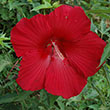
10" crimson blooms. Erect habit. Tolerates wet sites. USDA 5-9
110 found, showing page 1 of 8















